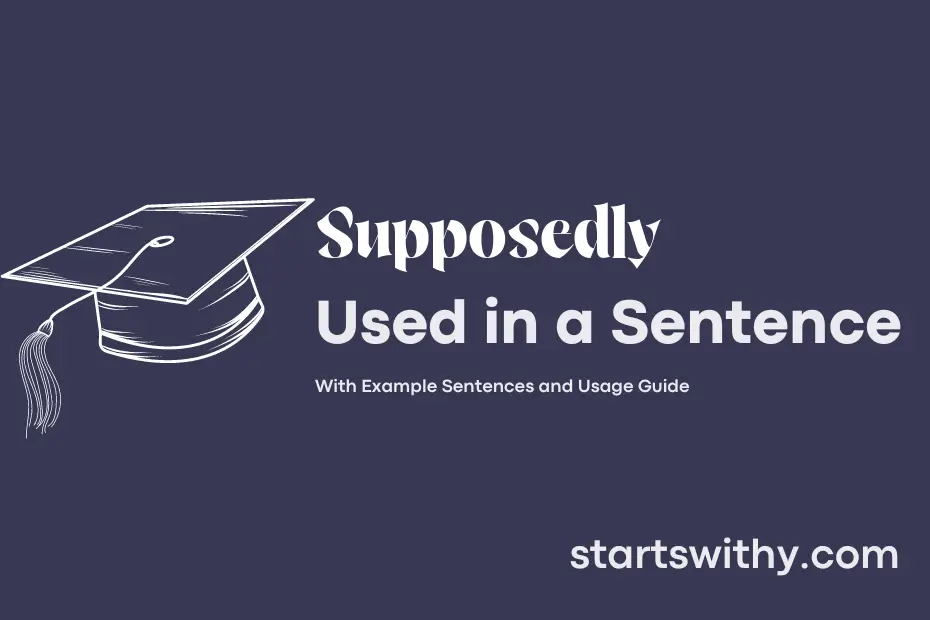Have you ever doubted the authenticity of a claim or information that was presented to you as true? You might have encountered the word “supposedly” in such instances.
“Supposedly” is an adverb used to convey that something is believed or assumed to be true, though there may be doubts or uncertainties surrounding its accuracy. It suggests that the information provided is not confirmed or proven beyond doubt.
7 Examples Of Supposedly Used In a Sentence For Kids
- Supposedly there are fairies living in the garden.
- The cat is supposedly afraid of water.
- Supposedly elephants have great memories.
- Supposedly the moon is made of cheese.
- The treasure is supposedly buried under the old tree.
- Supposedly there are monsters under the bed.
- Supposedly the stars twinkle in the night sky.
14 Sentences with Supposedly Examples
- Supposedly, the final exam is going to be really tough this semester.
- I heard that the deadline for the project was yesterday, supposedly.
- The professors are supposedly going to announce the results by next week.
- Supposedly, the library has extended its working hours during exams.
- The cafeteria is supposedly serving healthier options now.
- We are supposedly going to have a guest lecture from a renowned expert next month.
- The college is supposedly organizing a cultural fest next semester.
- Supposedly, the college is planning a picnic for all the students.
- The club meeting was supposedly rescheduled to next Friday.
- The college bus is supposedly arriving early today.
- The students’ feedback on the new course was supposedly taken into consideration.
- Supposedly, there will be a flash sale at the college bookstore next week.
- Our class is supposedly having a field trip as part of the curriculum.
- The sports fest is supposedly going to include new events this year.
How To Use Supposedly in Sentences?
Supposedly is used to express that something is believed or said to be true, though there may be doubts or uncertainties surrounding it. Here is a guide on how to use supposedly in a sentence for beginners:
-
Placement: Supposedly usually comes at the beginning or in the middle of a sentence. For example, “She supposedly finished her project yesterday.”
-
Indicating uncertainty: When using supposedly, you are suggesting that the information provided might not be entirely accurate. For instance, “The package was supposedly delivered this morning, but I can’t find it anywhere.”
-
Questioning validity: You can use supposedly to question the truthfulness of a statement or belief. For example, “The new restaurant is supposedly the best in town, but I haven’t had a good experience there yet.”
-
Adding skepticism: By including supposedly, you can introduce a sense of doubt or skepticism into your statement. For instance, “The meeting was supposedly scheduled for 2 p.m., but it seems like nobody received the memo.”
-
Emphasizing uncertainty: When you use supposedly, you are emphasizing that the information provided may not be fully reliable. For example, “The missing keys were supposedly found in the living room, but nobody has seen them there.”
Incorporating supposedly into your sentences can help convey doubts or uncertainties about the validity of information, making your communication more nuanced and precise.
Conclusion
In conclusion, the use of the word “supposedly” in sentences serves to express uncertainty, skepticism, or doubt about the truth or validity of a statement or claim. It is commonly used to indicate that something is believed to be true or intended to be a fact, but there may be reasons to question its accuracy. For example, “The witness supposedly saw the suspect at the scene of the crime” implies a degree of uncertainty about the witness’s claim.
By incorporating “supposedly” into sentences, speakers can convey a sense of caution or skepticism, prompting further investigation or critical thinking. This adverb adds nuance to statements, highlighting the potential for misinformation or unverified claims. Its usage in sentences prompts readers or listeners to consider the credibility and reliability of the information presented, enhancing effective communication.



